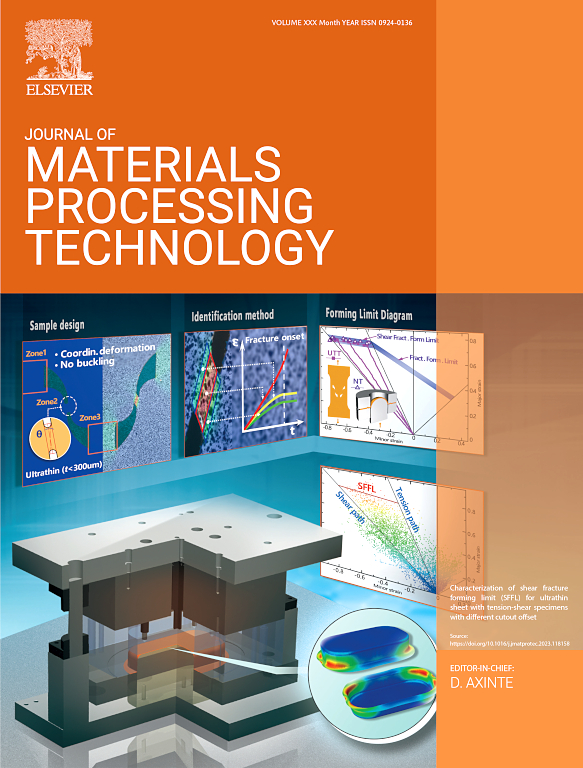A molten pool and keyhole dynamics study in near IR-blue hybrid laser welding of AZ31B magnesium alloy: A dual-mode synergy strategy for defect suppression in reflective low-melting materials
IF 6.7
2区 材料科学
Q1 ENGINEERING, INDUSTRIAL
Journal of Materials Processing Technology
Pub Date : 2025-03-22
DOI:10.1016/j.jmatprotec.2025.118814
引用次数: 0
Abstract
Magnesium alloy with excellent strength-to-weight ratio and good formability has been primarily applied in automotive and aerospace applications. However, the laser welding of magnesium alloys is often challenged by low absorption efficiency, tendency to oxidize, thermal sensitivity and susceptibility to evaporation because of low boiling point, leading to instability of molten pool and keyhole. In light of the current lack of sufficient research, the effects of blue and hybrid laser welding were clarified, and the mechanisms behind the observed phenomenons were analyzed in this study. The research found that near-infrared (NIR) laser welding caused porosity defects due to keyhole collapse and turbulent molten pools. Blue laser improved hardness (76.7 Hv) and strength (305.44 MPa) but induced discontinuous solidification from gravity-driven fluid accumulation. Hybrid laser welding stabilized the molten pool by reducing temperature gradients and stress concentrations, enhancing recoil pressure to counteract gravity. This achieved superior hardness (78 Hv) and maintained strength (287.86 MPa), with surface roughness reduced by 23.1 % compared to NIR and 3.5 % compared to blue laser, demonstrating synergistic benefits for magnesium alloy welding performance through optimized energy and fluid dynamics. This research not only employs an energy-morphology-defect correlation analysis to investigate the welding process of magnesium alloys which bridging critical knowledge gaps in blue and hybrid laser welding mechanisms but also introduces a interesting hybrid laser welding technique that overcomes the longstanding challenges in magnesium alloy welding, offering a substantial methodological innovation with potential applications in high-performance manufacturing industries.
AZ31B镁合金近红外-蓝混合激光焊接熔池和锁孔动力学研究:一种抑制反射性低熔点材料缺陷的双模协同策略
镁合金具有优异的强度重量比和良好的成形性,主要应用于汽车和航空航天领域。然而,镁合金激光焊接存在吸收效率低、易氧化、热敏性差、沸点低易蒸发等问题,导致熔池和锁孔不稳定。针对目前研究不足的问题,本文对蓝色激光和混合激光焊接的影响进行了澄清,并分析了观察到的现象背后的机制。研究发现,近红外(NIR)激光焊接由于锁孔塌陷和熔池湍流导致气孔缺陷。蓝色激光提高了材料的硬度(76.7 Hv)和强度(305.44 MPa),但由于重力驱动的流体积聚导致了不连续凝固。混合激光焊接通过降低温度梯度和应力集中,提高反冲压力来抵消重力,从而稳定熔池。与近红外激光相比,表面粗糙度降低了23.1% %,与蓝色激光相比降低了3.5 %,这表明通过优化能量和流体动力学,镁合金焊接性能具有协同效益。本研究不仅采用能量-形态-缺陷相关分析来研究镁合金的焊接过程,弥补了蓝色激光焊接和混合激光焊接机制的关键知识空白,而且还介绍了一种有趣的混合激光焊接技术,克服了镁合金焊接的长期挑战,提供了大量的方法创新,在高性能制造行业具有潜在的应用前景。
本文章由计算机程序翻译,如有差异,请以英文原文为准。
求助全文
约1分钟内获得全文
求助全文
来源期刊

Journal of Materials Processing Technology
工程技术-材料科学:综合
CiteScore
12.60
自引率
4.80%
发文量
403
审稿时长
29 days
期刊介绍:
The Journal of Materials Processing Technology covers the processing techniques used in manufacturing components from metals and other materials. The journal aims to publish full research papers of original, significant and rigorous work and so to contribute to increased production efficiency and improved component performance.
Areas of interest to the journal include:
• Casting, forming and machining
• Additive processing and joining technologies
• The evolution of material properties under the specific conditions met in manufacturing processes
• Surface engineering when it relates specifically to a manufacturing process
• Design and behavior of equipment and tools.
 求助内容:
求助内容: 应助结果提醒方式:
应助结果提醒方式:


